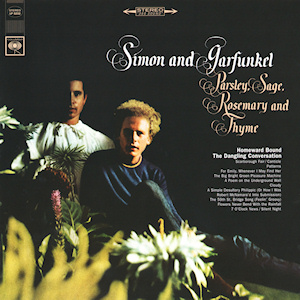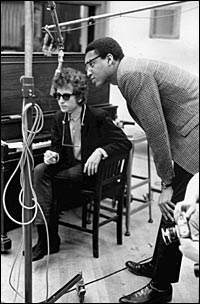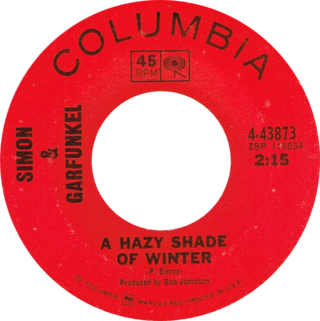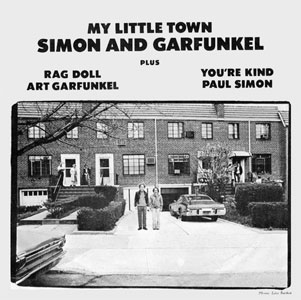
Simon & Garfunkel were an American folk rock duo consisting of the singer-songwriter Paul Simon and the singer Art Garfunkel. They were one of the best-selling music groups of the 1960s, and songs including "The Sound of Silence" (1965), "Mrs. Robinson" (1968), "The Boxer" (1969) and "Bridge over Troubled Water" (1970) reached number one on singles charts worldwide.

Parsley, Sage, Rosemary and Thyme is the third studio album by the American folk rock duo Simon & Garfunkel. Produced by Bob Johnston, the album was released on October 24, 1966, in the United States by Columbia Records. Following the success of the re-release of their debut single "The Sound of Silence", Simon & Garfunkel regrouped after a time apart while Columbia issued their second album, a rushed collection titled Sounds of Silence. For their third album, the duo spent almost three months in the studio working on instrumentation and production.

Bookends is the fourth studio album by the American folk rock duo Simon & Garfunkel. Produced by Paul Simon, Art Garfunkel and Roy Halee, the album was released on April 3, 1968, in the United States by Columbia Records. The duo had risen to fame two years prior with the albums Sounds of Silence and Parsley, Sage, Rosemary and Thyme and the soundtrack album for the 1967 film The Graduate.

"The Sound of Silence" is a song by the American folk rock duo Simon & Garfunkel, written by Paul Simon. The duo's studio audition of the song led to a record deal with Columbia Records, and the original acoustic version was recorded in March 1964 at Columbia's 7th Avenue Recording Studios in New York City for their debut album, Wednesday Morning, 3 A.M., released that October to disappointing sales. An overdubbed electric remix was released the following year and went to number one on the Billboard singles chart.

"America" is a song performed by American music duo Simon & Garfunkel, which they included on their fourth studio album, Bookends, in 1968. It was produced by the duo and Roy Halee. The song was later issued as the B-side of the single "For Emily, Whenever I May Find Her " in 1972 to promote the release of the compilation album Simon and Garfunkel's Greatest Hits. After peaking in the charts in July 1972, the song was switched to the A-side of the single and re-entered the charts in November 1972.

Thomas Blanchard Wilson Jr. was an American record producer. He is best known for his work in the 1960s with acclaimed artists such as Bob Dylan, Frank Zappa and the Mothers of Invention, Simon & Garfunkel, the Velvet Underground, Cecil Taylor, Sun Ra, Eddie Harris, Nico, Eric Burdon and the Animals, the Blues Project, the Clancy Brothers and Tommy Makem, and others.

"I Am a Rock" is a song written by Paul Simon. It was first performed by Simon as the opening track on his album The Paul Simon Songbook which he originally recorded and released in August 1965, only in the United Kingdom. Paul Simon and Art Garfunkel, as the American folk rock duo Simon & Garfunkel, re-recorded it on December 14, 1965, and included as the final track on their album Sounds of Silence, which they released on January 17, 1966. It was released as a single in 1966, and subsequently included as the B-side of the 1971 A-side reissue of "The 59th Street Bridge Song ".

"Homeward Bound" is a song by the American music duo Simon & Garfunkel, released as a single on January 19, 1966, by Columbia Records. It was written by Paul Simon and produced by Bob Johnston. Simon wrote the song during his time in England, possibly while waiting for a train at Widnes railway station in the northwest of England. Although Widnes railway station is most often cited as the location where it was composed, Simon said in an interview on the Norwegian-Swedish television chat show Skavlan in 2016, that it was actually a railway station in Warrington where he began to compose the song.

"Mrs. Robinson" is a song by American folk rock duo Simon & Garfunkel from their fourth studio album, Bookends (1968). The writing of the song was begun before the 1967 film The Graduate, which contained only fragments of it. The full song was released as a single on April 5, 1968, by Columbia Records. Produced by Simon & Garfunkel and Roy Halee, the song was written by Paul Simon, who offered parts of it to movie director Mike Nichols alongside Art Garfunkel after Nichols rejected two other songs intended for the film. The Graduate's soundtrack album uses two short versions of "Mrs. Robinson". The song was additionally released on the Mrs. Robinson EP in 1968, which also includes three other songs from the film: "April Come She Will", "Scarborough Fair/Canticle", and "The Sound of Silence".

"Cecilia" is a song by American musical duo Simon & Garfunkel. It was released in April 1970 as the third single from the duo's fifth and final studio album, Bridge over Troubled Water (1970). Written by Paul Simon, the song's origins lie in a late-night party, in which the duo and friends began banging on a piano bench. They recorded the sound with a tape recorder, employing reverb and matching the rhythm created by the machine. Simon later wrote the song's guitar line and lyrics on the subject of an untrustworthy lover.

Sounds of Silence is the second studio album by the American folk rock duo Simon & Garfunkel, released on January 17, 1966. The album's title is a slight modification of the title of the duo's first major hit, "The Sound of Silence", which originally was released as "The Sounds of Silence". The song had earlier been released in an acoustic version on the album Wednesday Morning, 3 A.M., and later on the soundtrack to the movie The Graduate. Without the knowledge of Paul Simon or Art Garfunkel, electric guitars, bass and drums were overdubbed under the direction of Columbia Records staff producer Tom Wilson on June 15, 1965. This new version was released as a single in September 1965, and opens the album.

"A Hazy Shade of Winter" is a song by American music duo Simon & Garfunkel, released on October 22, 1966, initially as a stand-alone single, but subsequently included on the duo's album Bookends (1968). It peaked at number 13 on the Billboard Hot 100.

"The Dangling Conversation" is a song by American music duo Simon & Garfunkel, released in September 1966 as the second single from the duo's third studio album, Parsley, Sage, Rosemary and Thyme (1966).

"My Little Town" is a 1975 song by the American duo Simon & Garfunkel. It was written by Paul Simon, who produced the track along with Art Garfunkel and Phil Ramone. The song was included on the 1975 solo releases from both Simon and Garfunkel (Breakaway). It would not appear on any of the duo's albums until the 1997 anthology box set Old Friends and the 1999 compilation album The Best of Simon and Garfunkel. It was the first single release credited to the duo since the 1972 release of "America", released in conjunction with Simon and Garfunkel's Greatest Hits.

"For Emily, Whenever I May Find Her" is a song written by Paul Simon and recorded by American music duo Simon & Garfunkel on their third studio album, Parsley, Sage, Rosemary and Thyme (1966). It is sung solely by Art Garfunkel, and consists mainly of his vocals with heavy reverb and a 12-string acoustic guitar. The lyrics concern finding a lover, although Simon once characterized the subject matter as being about a "belief," rather than about a specific individual.
"The Big Bright Green Pleasure Machine" is a 1966 song by Paul Simon released on Simon & Garfunkel's album Parsley, Sage, Rosemary and Thyme, and as a B-side of "The Dangling Conversation", which charted at number 25 on Billboard's Hot 100. It is a commentary on advertising.

Bridge over Troubled Water is the fifth and final studio album by the American folk rock duo Simon & Garfunkel, released on January 26, 1970, by Columbia Records. Following the duo's soundtrack for The Graduate, Art Garfunkel took an acting role in the film Catch-22, while Paul Simon worked on the songs, writing all tracks except Felice and Boudleaux Bryant's "Bye Bye Love".
"Leaves That Are Green" is a song written and originally recorded by Paul Simon for his 1965 album The Paul Simon Songbook. It was later re-recorded with Art Garfunkel for the 1966 album Sounds of Silence, adding an electric harpsichord, rhythm guitar, and bass. It was also the B-side to the hit song "Homeward Bound".

The Concert in Central Park is the first live album by American folk rock duo Simon & Garfunkel, released on February 16, 1982, by Warner Bros. Records. It was recorded on September 19, 1981, at a free benefit concert on the Great Lawn in Central Park, New York City, where the pair performed in front of 500,000 people. A film of the event was shown on TV and released on video. Proceeds went toward the redevelopment and maintenance of the park, which had deteriorated due to lack of municipal funding. The concert and album marked the start of a three-year reunion of Paul Simon and Art Garfunkel.

















